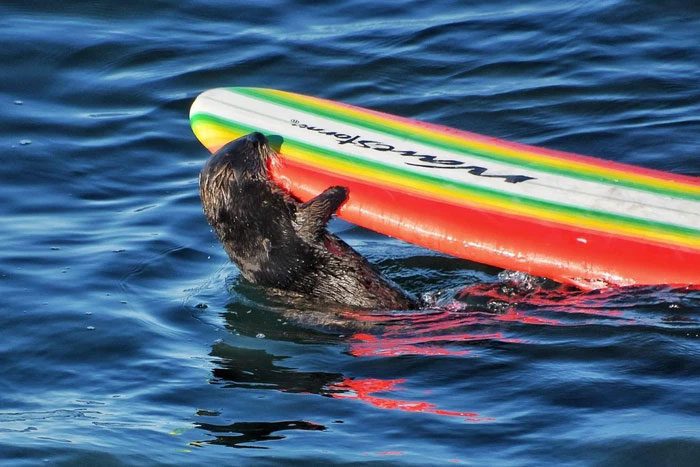Sharks are a major threat to surfers along the California coastline (USA). However, tourists now also need to be cautious of sea otters after a five-year-old sea otter has been repeatedly attacking and stealing surfboards from beachgoers.
Along West Cliff Drive, the United States Fish and Wildlife Service has placed numerous signs warning that “Aggressive otters are in the area. Consider staying out of the water and avoiding marine wildlife.”

The otter chases away tourists and casually takes their surfboard.
According to the Los Angeles Times, several incidents of sea otter attacks were recorded last year, but recently the number of attacks has increased significantly. One notable case involves a five-year-old otter named Otter 841, which has attacked, chased away tourists, and even taken their surfboards.
Joon Lee, a novice surfer and one of the victims of Otter 841, shared: “I was really scared and tried to swim away, but the otter managed to bite the leash of my board.”
Before Lee could escape, the otter charged at him and damaged his surfboard. After this terrifying experience, he may never dare to surf again.
Reasons for Sea Otter Attacks on Humans
Marine animal experts emphasize that otters almost never attack humans. Jessica Fujii, the leader of the Sea Otter Program at the Monterey Bay Aquarium, explained: “This is very unusual and rare. I don’t think this behavior is common among otters. Although we have witnessed a few similar cases in recent years, this particular behavior of the otter is quite exceptional.”
It is known that Otter 841’s mother was previously captive but was released back into the wild, only to be captured again for climbing onto a sports boat to find food. During her second captivity, she gave birth to Otter 841. After weaning, the otter was separated from her mother and raised at the aquarium.


Otters almost never attack humans.
Otter 841 has lost its fear of humans in the wild after interacting with the staff there, although they have tried to wear protective gear to avoid becoming too familiar with the otter.
Fujii added: “After being released back into the wild for a year, we received reports of Otter 841 attacking surfers. We don’t know the reason for this behavior, nor have we seen any tourists feeding the otter. But this has been happening throughout the summer for the past few years.”
As a result, wildlife care staff decided to capture Otter 841 again. This decision was made to ensure the safety of both tourists and the otter.
It is known that the California sea otter, also referred to as the southern sea otter, used to thrive along the California coast. However, large-scale hunting in the 19th century led them to become a critically endangered species, with only about 3,000 otters remaining today. Despite their low population numbers, if Otter 841 continues to bite people, officials may have to euthanize it to ensure safety.
So far, staff have been unable to capture the otter. Fujii stated: “It is very clever and knows how to escape from us.”




















































